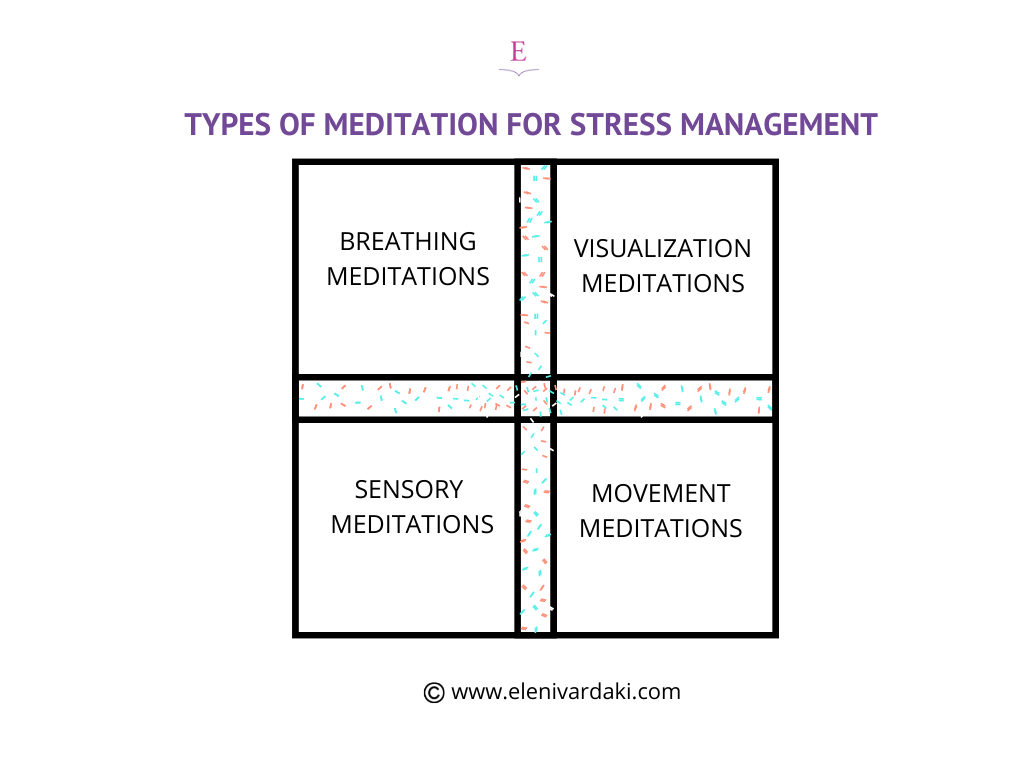
Types of Meditation for Stress Management
WHAT’S THE ISSUE: Looking for ideas of how you can expand your stress management ‘toolbox’ with a new type of meditation? In this article, you will find 22 examples of types of meditation for stress management you may want to look into. I organized these examples into 4 types of meditation: breathing, visualization, movement, and sensory (grounding).
TYPES OF MEDITATION: WHY TRY DIFFERENT ONES?
There are more types of meditation than just breathing exercises and sitting meditations. We often see the word ‘meditation’ accompanied by a photo of someone (usually a woman) sitting still (usually cross-legged) with their eyes closed. Or with their back to the camera.
You may find that different types of meditation suit you and your schedule better at different times in your day, week, or even year. You may, for example, want to practice movement-based meditations, like consciously practicing mindful walking, when you don’t have time for a daily sitting meditation practice. During peak work seasons, knowing how to practice a movement meditation allows us to be more mindful when have a lot on our minds and are on the go.
TYPES OF MEDITATION: WHAT ARE YOUR OPTIONS?
“Ms, you won’t believe what’s going on in American universities. I go into the uni library, and by 5pm everyone’s eyes glaze over; the focus pills they take to help them concentrate and cram before an exam or a deadline have stopped working. They look like zombies. And then at night, they can’t sleep. So they take sleeping pills to sleep. But because sleeping pills are only sedatives and not really ‘sleeping’ pills…they then take focus pills again in the morning, to try and focus to get their assignments done!”
A former high school student of mine (undergraduate student in the USA)
Meditation is a type of focus training; to meditate is to practice consciously focusing your attention. One of the consequences of going through a very stressful time in our life is that it can get very hard to focus on the study and/or work responsibilities we have to accomplish.
It is, of course, possible to sidestep the opportunity to develop our stress management skills by taking ‘focus’ pills and ‘sleeping’ pills during very stressful times in our life. You may be here because you want to improve your stress management skills as a way of complementing the pills you are taking. Or you may be someone who is not taking medication. You are not mentally ill. But you have been going through a very stressful time in your life. Either way, you are someone who is open to building your stress management toolbox for your mental health.
Either way, below you will find a wide variety of types of meditations I’ve organized into 4 overlapping categories (see diagram below). As you can see there are many types of sitting and movement-based meditations. And it’s also possible to mix and match, and combine different stress management tools and techniques (notice the overlapping areas in the diagram below).

There is no one way to organize the different types of meditation that exists. I’ve just organized them into these four categories to create a diagrammatic teaching tool for my work teaching mindfulness-based adult SEL (Social and Emotional Learning) to kids and adults.
The confetti-filled intersections of the diagram are there to remind you that these categories aren’t fixed; they can be mixed and matched in countless ways. For example, you can do a breathing meditation before doing visualization meditation. Or you can do a short sensory grounding meditation before doing a movement-based meditation, like EFT Tapping.
Experiment with different combinations. Play with different options. Make it your own.
TYPES OF MEDITATION: WHAT HAVE YOU TRIED?
I’ve organized the four main types of meditation into lists of examples. Notice which ones spark your curiosity enough to want to learn more as you read:
1. BREATHING MEDITATIONS
- 7-11 breathing meditations
- Alternate nostril breathing meditations
- Breath of fire meditations
- Triangle breathing, or Square breathing meditations
- Bubble breathing meditations
- 5 Finger breathing / Starfish breathing (for primary and Pre-K kids)
2. VISUALIZATION MEDITATIONS
- Success visualization/goal achievement visualization meditations
- Color breathing meditations
- Body awareness/body scan/progressive muscle relaxation meditations
- Heart breathing/heart coherence meditations
- Loving-kindness/compassion meditations
- Gratitude meditations
- Imagery meditations (e.g. ‘happy place’ meditations, relaxing nature visualization meditations)
3. MOVEMENT MEDITATIONS
- Walking meditations
- Drawing meditations/coloring book meditations (e.g. mandala meditations)
- Writing meditations
- Tapping meditations (e.g. EFT Tapping meditations, Butterfly tapping/ Butterfly hug meditations)
- Other types of movement meditations (e.g. Yin Yoga, Qigong)
4. SENSORY MEDITATIONS
- Mindful eating meditations
- 5-4-3-2-1 (or 3-2-1) sensory meditations
- Silent meditations
- Focused attention sound meditations (e.g. circles of sound awareness, gong bath, solfeggio frequencies, A.S.M.R sound meditations)
I invite you to see this list as a springboard to launch or expand your emotional self-care practice. It’s not an exhaustive list of all the types of meditation you could try. These are just the types of meditation that I have practiced for managing stress in the last 20+ years. I started exploring the world of meditations for stress relief when I was a teenager living in Islamabad, Pakistan. And when I felt ready to teach from my experience, I started teaching them to others.
Wherever you are in your meditation skills journey, just start from where you are, and build.
"ARE THESE TYPES OF MEDITATION RELIGIOUS/SPIRITUAL?"
I’m aware that some of these meditations can be taught in a way that mixes religion with stress management, so I want to address this issue. Especially since some people worry about whether a meditation is religious or spiritual. This is an understandable concern to have because some teachers do indeed mix stress management training with spiritual teachings.
Spiritual education can overlap with emotional education, and some professionals do indeed integrate religion or spirituality into their teachings. For example, some yoga teachers bring in spiritual teaching in their yoga classes. Similarly, you will find mindfulness teachers who also teach about spirituality.
Speaking for myself, I only teach secular types of meditation in my private practice and consulting work with schools. I work with people who have different religions and spiritual lives, which I respect. Education and human psychology are different from spiritual and religious education. I’m a secular educator working with people and schools who are ready to learn practical, easy-to-do ways of developing their stress management skills, reducing anxiety, and increasing focus and motivation during very stressful times in their life.
Are you someone who worries about whether the teacher or course you are thinking of investing in teaches religiously or spiritually? Just can ask for clarification on this issue before you decide to invest your money and energy into something new. If it’s not a match, just move on and find what feels right for you!
About the author

Eleni Vardaki works online supporting parent, teacher, and student well-being. Her mission is to help bridge the gap between mainstream education systems and the well-being skills we need to thrive. She believes in doable, sustainable interventions for student well-being in school and family cultures that value student and community well-being. For business inquiries, you can email her at: eleni@elenivardaki.com
TRY ELENI'S SHORT AUDIO MEDITATION
https://elenivardaki.com/free-meditation-sign-up/



